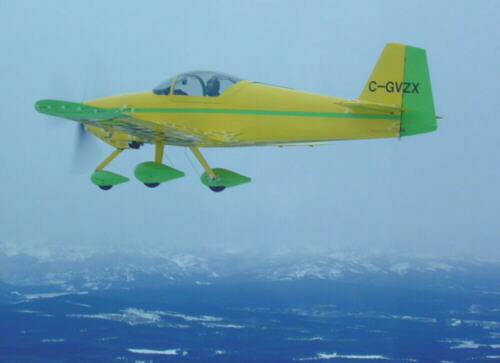

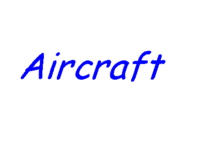
Engine hours to date 417.4

06/18/04
We did a short cross country flight to Sundre to get some speeds and check heat exchanger performance. The oil temperature got a little high in the climb at 110C so this will have to be addressed. Intercooler and radiator performance was good. Coolant temperatures did not exceed 80C in the climb. In level flight at 11,500 feet at 4200 rpm and 25 inches we were seeing 144 knots true on 53 lbs./hr., leaned at -6%. Oil temperature in cruise was 93C and coolant temp was 70C.
06/23/04
We have done some flights in progressively higher ambient temperatures and now find the oil temperatures are getting too high during climbout. We have now flown to 22C ambient and are seeing the oil temperature in the pan rising to 135C and the temperature after the cooler getting to 105-110C with 115C being the limit here. Additional cooling for the oil will have to be added for summer operation it appears. This will temporarily preclude any performance testing for a while.
06/25/04 VZX Handling
Our RV6A might handle and perform a little differently than Lycoming powered models so we publish this information for the interest of our readers.
The runup is accomplished with the IVO propeller set at 3 amps fine. Minimum water and oil temperature is 60C. Throttle is fully advanced. Manifold pressure is usually 37-39 inches and rpm is verified at 4500-4800.
Flaps are retracted for takeoff. The takeoff involves slowly feeding in throttle and right rudder as the speed rapidly builds. The rudder is highly effective but up to 1/3rd travel may be required at full power going through 30-40 knots to stay on the centerline. As the rudder becomes more effective, rudder pressure is almost fully released by rotation speed. The prop really starts to bite at about 30 knots and the boost presses you in the seat. It takes 6-9 seconds depending on weight, temperature and throttle movement to go from zero to the rotation speed of 60 knots. A slight back pressure on the stick and you are flying and quickly accelerating to the best climb speed of 85 knots. Power is reduced to 35 inches and 4500-4800 rpm.
The climb angle is very steep at 85 knots, especially when the aircraft is light. Visibility over the nose is poor so we often use 90-95 knots for better view of traffic and cooling airflow. Climb in the summer at 85 knots at gross weight is about 1000 feet/min. at 35 inches and about 600 feet/min. at 95 knots. In the winter at light weight and solo, we see as much as 2200 feet/min. Minimal rudder is required to keep the ball centered. A little forward elevator trim is used at this power setting. Above 9500 feet, the throttle is fully open to maintain 35 inches and the wastegate control must be turned as the climb continues.
Cruise is set up at one of three power settings: economy is 4400/22 inches, normal is 4600/25 inches and fast is 4600/30 inches. Manifold pressure is adjusted first, then prop pitch. Mixture is leaned to a certain Air/fuel ratio or EGT. Typically we lean 6-15% from the default computer settings (best power). If we are lazy, the altitude and heading hold modes are engaged on our Eze Trim and Navaid auto pilots. We then monitor gauges, Monroy traffic warning TPAS and keep a lookout for traffic. Tanks are switched about every 45 minutes.
Descent can be with power on or off. RPM is adjusted for 4200 or above to reduce vibration levels.
Circuits are flown at about 3700-4200/ 22 inches and 90-100 knots. Approach is at 75-85 knots clean and 70-80 knots with half flap. Flap improves visibility over the nose considerably. Over the fence at 65-75 clean and 60-70 with half flap. A bit more power with flaps is required for a controlled descent rate. A slight amount of power is carried into the flare. A positive angle of attack is required to prevent wheelbarrowing. View is switched out the corner of the windshield as forward view is non-existant and you feel for the runway. Touchdown is at around 55-60 knots. Backpressure is applied on touchdown to hold the nosewheel off as long as possible to prevent shimmy. Half flaps require a fair amount of back trim to reduce elevator pressure, full flap even more. With full flap, an early flare is required and quite a pull to be sure attitude is correct on touchdown. The aircraft lands much better either clean or with half flap. Touch and goes are not like most light aircraft. As soon as the engine is firewalled, the aircraft is in the air again- instantly.
All in all, the RV6A is a very pleasant aircraft to fly with responsive, light and well harmonized controls.
07/15/04
We did a long flight test from our home base at Springbank to Rocky Mountain House to verify speeds and fuel flows at different power settings and altitudes. The chart below lists the data recorded:
| Den Alt | 11000 | 12000 | 9500 | 10000 | 11000 | 8000 | 13000 |
| Altitude | 10500 | 11500 | 8500 | 8500 | 9500 | 6500 | 11500 |
| OAT C | -5 | -5 | 6.5 | 8 | 6.5 | 15 | 5 |
| IAS KTS | 120 | 118 | 118 | 129 | 130 | 118 | 130 |
| TAS KTS | 144 | 144 | 136 | 149 | 152 | 136 | 158 |
| MAP | 25 | 25 | 25 | 30 | 30 | 25 | 30 |
| RPM | 4200 | 4200 | 4200 | 4300 | 4200 | 4200 | 4400 |
| Prop amps | 10C | 11C | 5C | 12C | 13C | 6C | 14C |
| Mix knob | -5% | -5% | -5% | -5% | -5% | -5% | -15% |
| Weight | 1700 | 1650 | 1700 | 1650 | 1700 | 1700 | 1650 |
| Ign | 32 | 32 | 32 | 32 | 32 | 32 | 32 |
| Duty | 31% | 32% | 33% | 39% | 39% | 31% | 36% |
| Wat Press | 5 | 7 | 7 | 7 | 5 | 7 | 7 |
| ET C | 70 | 70 | 70 | 70 | 70 | 80 | 80 |
| AT | 24 | 25 | 34 | 37 | 37 | 39 | 40 |
| INDT | 58 | 61 | 65 | 69 | 70 | 69 | 77 |
| Oil T | 96 | 93 | 93 | 93 | 95 | 96 | 100 |
| FF lbs. | 53 | 53 | 54 | 65 | 63 | 51 | 59 |
| EGT 1 F | 1290 | 1281 | 1292 | 1298 | - | 1275 | 1389 |
| EGT 2 | 1341 | 1338 | 1307 | 1306 | - | 1284 | 1371 |
| EGT 3 | 1244 | 1236 | 1250 | 1246 | - | 1230 | 1326 |
| EGT 4 | 1268 | 1260 | 1260 | 1239 | - | 1252 | 1294 |
| OT 2 | - | - | - | - | - | - | - |
| WT3 | 69 | 67 | 70 | 70 | 69 | 79 | 77 |
| RDT | 65 | 64 | 75 | 73 | 70 | 73 | 75 |
| WT2 | - | 53 | 61 | 61 | 59 | 67 | 64 |
We learned some interesting things with leaning the engine. As we leaned the engine from an air/fuel ratio of about 12.5 to 1 to about 13.6 to 1, the engine picked up some hp and we had to coarsen the propeller pitch to bring the rpm down to where it was before. Fuel flow went down to 46 lbs./hr. at 25 inches and 4200 rpm. EGT 1 went to 1379F and TAS was 130 knots at only 6500 feet. Likewise above at a density altitude of 13,000 feet at 30 inches and 4400 rpm, leaned to -15% we saw 158 knots TAS at 59 lbs./hr. We have not finished leaning experiments yet. If we can lean to an AFR of around 15 to 1, we should see fuel flows drop down to close to Lycoming levels at a similar TAS. Right now, performance is limited by the propeller/redrive ratio combination. We are pitched full coarse at high altitude at 30 inches MAP to keep rpm below 4500 for cruise.
We'll get some oxygen installed sometime in the future and get the aircraft up to 15,000 or so to get some more numbers. We'll also continue the leaning experiments and document those.
07/19/04
In an attempt to lower fuel flows, the next series of tests will involve changing the ignition timing in flight to check optimal advance setting for hp and EGT reductions. We have set an EGT limit of 1400F for the time being to ensure we operate below the turbocharger temperature limits. The SDS engine management system allows us to change the timing in real time.
07/22/04
A test flight to Vulcan (not the planet) changing the ignition timing of the EJ22T in flight via the SDS programmer revealed some interesting data. Density altitude was 8500 feet MSL, OAT +8C, mixture knob at -10%:
| IAS knots | 118 | 115 | 113 | 125 | 123 | 122 | 130 | 130 | 130 |
| TAS | 134 | 130 | 128 | 142 | 138 | 137 | 147 | 147 | 147 |
| RPM | 4200 | 4100 | 4050 | 4200 | 4100 | 4050 | 4200 | 4200 | 4200 |
| MAP | 25 | 25 | 25 | 27 | 27 | 27 | 30 | 30 | 30 |
| IGN | 32 | 34 | 36 | 32 | 34 | 36 | 32 | 34 | 36 |
| EGT 1 | 1292 | 1276 | 1257 | 1294 | 1283 | 1278 | 1297 | 1292 | 1286 |
| EGT 2 | 1328 | 1313 | 1297 | 1336 | 1327 | 1311 | 1314 | 1311 | 1303 |
| EGT 3 | 1275 | 1256 | 1241 | 1275 | 1258 | 1253 | 1271 | 1266 | 1262 |
| EGT 4 | 1300 | 1281 | 1264 | 1300 | 1280 | 1268 | 1269 | 1276 | 1270 |
Propeller pitch was not changed during this test so any loss in rpm and IAS indicates a loss in hp as timing was advanced. It's interesting to note that EGT dropped a fair amount at 25 and 27 inch MAP power settings and the engine lost power as timing was advanced. At 30 inches however, rpm and speed stayed constant as timing was advanced and EGT dropped little. Note the small EGT spread at 30 inches of only 45F. This indicates relatively equal mixture distribution. In light of this data, we'll continue for the time being operating the RPM ignition timing at its original setting of 32 degrees BTDC at high rpm. This seems like a good compromise between power and EGT to allow reasonable leaning in cruise.
So far we have seen typical speeds and fuel flows as below at various altitudes and power settings. Note that VZX is not fitted with wheel pant intersection fairings or a nose wheel leg intersection fairing at this time which might be worth 1-3 extra knots.
8,000 to 12,000 feet MSL, 4200 rpm, 25 inches MAP, fuel flow 43-45 lbs./hr., TAS 134-144 knots
8,000 to 12,000 feet MSL, 4200 rpm, 27 inches MAP, fuel flow 47-50 lbs./hr., TAS 139-148 knots
8,000 to 12,000 feet MSL, 4200-4400 rpm, 30 inches MAP, fuel flow 56-60 lbs./hr., TAS 146-158 knots
Leaned to about 13.6-13.8 air/fuel ratio, keeping EGTs below 1400F, we see a BSFC of .46 lbs./hp/hr. at cruise power settings of 4200-4400 rpm and 25-30 inches MAP. We may be able to better this with further experimentation however we are breaking new ground here for which no safe figures currently exist.
Speeds at higher oxygen levels are likley to be a bit higher which we intend to test soon.
07/25/04
We did some more tests at 11,000 MSL, OAT +10C running 4800 rpm/ 35 inches, prop +12 amps, IAS 140 knots, TAS 170 knots, GPS average 166 knots. Knob was at 0%, fuel flow 83 lbs./hr., EGT 1, 1300F, INDT 85C, AT 50C. We can likely get the same performance leaned to a fuel flow of 70 lbs./hr.
For practical cruising from a fuel flow, induction and engine air temperature limits, we'll likely limit cruise power settings to 4400 rpm and 30 inches. At 12,000-16,000 feet, we should be able to get 158-165 knots TAS at about 9.5 US gallons/hr. fuel flow. This matches the average RV6A with a Lycoming O-360 and constant speed prop, but at a much higher altitude. The cooling drag of our setup is likely inferior to the air cooled engine. The Lycoming would seem to be superior below 10,000 feet in speed. I suppose the big difference is powerplant cost. The O-360 with C/S prop will set you back in excess of $30,000US. My engine, redrive and prop came to about $10,000. I can buy a lot of fuel and oxygen for $20,000.
08/02/04
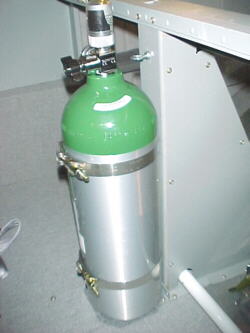
We have the Aerox 2M oxygen bottle now mounted to the flap motor housing structure via two stainless band clamps. The bottle and clamps can be removed in less than 2 minutes when not required. Installation weighs about 10 lbs. Provides about 13 hours use at 15,000 feet with 2 people using the oxysaver cannulas. We're ready for some higher altitude testing now.
08/05/04
Our flight test at 15,000 feet, OAT 0C, density altitude 17,000, prop at 14 amps coarse, revealed the following at a weight of 1690 lbs.:
25 inches 4400 rpm, mixture -14%, fuel flow 47 lbs./hr. 152 knots TAS, GPS average 153 knots. EGT 1 1351F. Turbo pressure ratio 1.58. AT 40C, INDT 81C
27 inches 4500 rpm, mixture -15%, fuel flow 50 lbs./hr. 156 knots TAS, GPS average 157 knots. EGT 1 1362F. Turbo pressure ratio 1.71.
30 inches 4600 rpm, mixture -16%, fuel flow 58 lbs./hr. 167 knots TAS, GPS average 170 knots. EGT 1 1382F. Turbo pressure ratio 1.90. AT 52C, INDT 96C.
34 inches 5000 rpm, mixture -10%, 181 knots TAS.
Fuel flow in the climb at 33 inches/ 4800 rpm, knob 0% was 76 lbs./hr. Climb rate was around 700 feet/min. at 100 knots IAS at 15,000 feet. We had to coarsen the prop pitch every couple of minutes during the climb to keep rpm at 4800 due to the decreasing air density. We did a continuous climb from 4000 MSL to 15,000 feet. Coolant temperatures stayed at 90C, oil temp at 110C. These lowered to 80 and 100 respectively in level flight so the cooling is not too bad at these ambient temperatures.
08/12/04
I did a few more training flights to verify cooling in the climb. These seem fine at 90+ knots at ambient temperatures up to +22C. A couple of practice forced approaches revealed a descent rate of around 1000 fpm at 80-85 knots IAS. This corresponds to a glide ratio of around 8.3 to 1. I will soon be performing the annual inspection so the aircraft will be down for a couple of days.
08/19/04
The annual inspection revealed no problems and the post inspection test flight showed all is fine so we'll start flying the aircraft further from base to various fly ins and airshows, this summer and fall. These flights will be detailed in the new Trips section.
11/22/04
We finally got to compare apples to apples as far as aircraft and answer the questions about Lycoming vs. Subaru by doing a fly off between our RV6A and friend Les Davenport's Lycoming powered RV6A based in High River, Alberta. As close as I can tell, our aircraft weighed about 1658 lbs. for takeoff and Les' about 1590 lbs. (due in part to different fuel loads) Les' aircraft is fitted with an 180hp O-360 and Hartzell C/S prop. Along to take photos and assist was my father, John Farnham and mutual friend, Bob Harris. As a sidenote, our aircraft was not fitted with the lower main gear intersection fairings or upper nose gear leg intersection fairing. In previous testing, these were shown to be worth 2-3 knots when temporarily taped in place.
After briefing on the basic plan, frequencies and formation details, we fired up. Les took off first and we turned east to head out towards the Vulcan area for the tests. I initially thought I had a propeller problem, being unable to adjust pitch but found that the prop arm switch was off. That being corrected, we proceeded to take some photos of each other, then did a climb test at 85-90 knots from about 6000 to 9000 feet. Les used full throttle and I used my normal climb power of 35 inches/ 4600-4800 rpm. Les pulled away initially as I had to fine out my prop pitch as the airspeed fell off. It dropped to 4200 rpm for about 10 seconds. Once I got this set up again, we slowly started to catch Les. VSIs were very similar through 8000 feet. We both arrived at 9000 feet at about the same time. Assuming optimal technique and equal aircraft weights, it would appear that the Lycoming/ Hartzell combination is slightly superior in climb rate to the Subaru/ IVO combo below 6000 feet. At 6000 to 8000, they would be very equal. Above 9000, the turbocharged engine has an advantage.
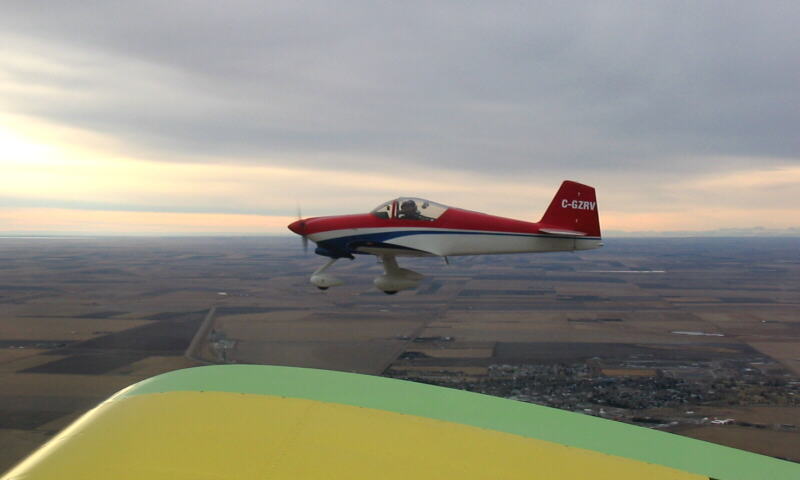
We levelled out at 9000 feet to do the speed runs. Again, Les selected full throttle and played with the prop pitch a bit to get the highest IAS and GPS ground speed. I selected 33-34 inches and 4600 rpm. As speed built up, we called out our IAS and GPS speeds. These were virtually identical, give or take a knot or two. I would normally use no more than 30 inches for cruise so even with fairings on my aircraft, I would concede that Les' aircraft would be 1-3 knots faster at 9000 feet. We were both truing around 170 knots. GPS readings were within 1-2 knots in most cases.
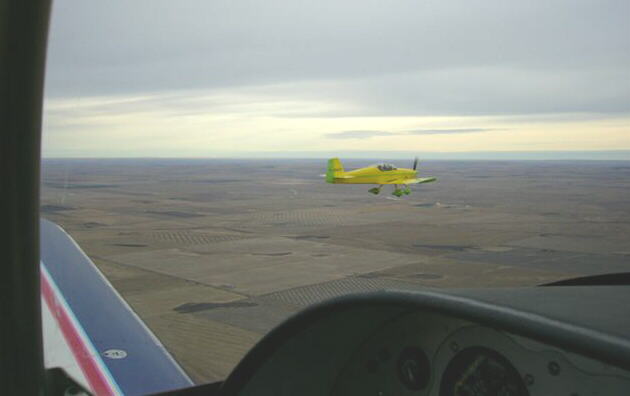
We both did a cruise climb to 12,000 feet. Above 10,000 feet, the turbo Subaru could slowly pull away from the the Lycoming in the climb. Levelling out at 12,000, I used 30 inches 4600 rpm. Again, speeds were very close. with fairings and equal weight, I would give a 1-3 knot advantage up here to the Subaru turbo. Fuel flows with both engines leaned out appeared to be similar. The Lycoming maybe having a slight advantage here.
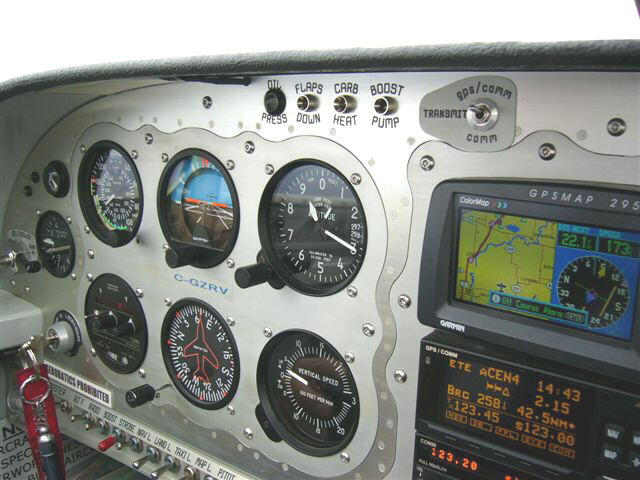
Les' beautiful CNC'd panel in flight
In summary, despite being completely dissimilar firewall forward, the two powerplants provide surprisingly similar performance.
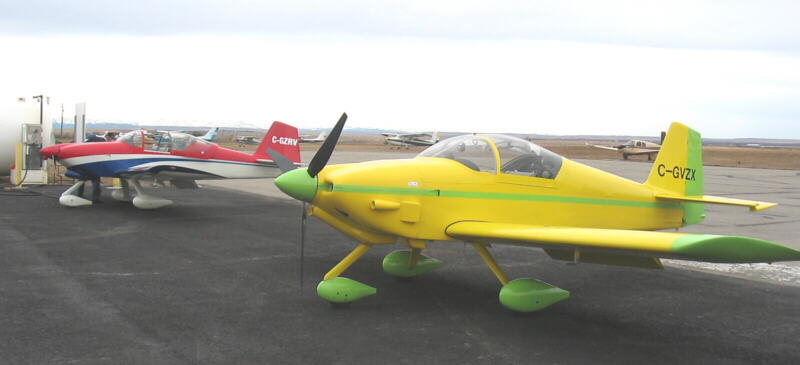
After the fly off at High River
03/30/05
We are now flying again and testing the new turbo compressor. At low altitudes so far, compressor discharge temps are roughly the same as with the smaller compressor. We will be conducting some climb tests at higher manifold pressures soon to see if there is a reduction in temps at higher pressure ratios.
03/05/09
It's about time for another update- it's been about 4 years now. How time flies. The airplane has been flow to Reno, NV and back and has undergone mods to the turbo scavenge system with a smaller, lighter pump, better warning systems for low voltage, a change in coolant from Evans NPG+ back to EGW mix and a change in fuel systems to eliminate weight and complexity. I had to remove the left wing tank twice to fix fuel seepage from around the sending unit. The engine compression has been generally slowly falling on each check. I've attributed this to lead form the fuel jamming up the rings and not allowing a proper valve seal. I've tried various additives to reverse this but the trend continues. I switched to Aeroshell oil for about 20 hours with no effect. Now, I've switched to burning a blend of 80% premium unleaded and 20% 100LL in hopes this will help. Other than the fuel leaks, the airplane has been remarkably trouble free.